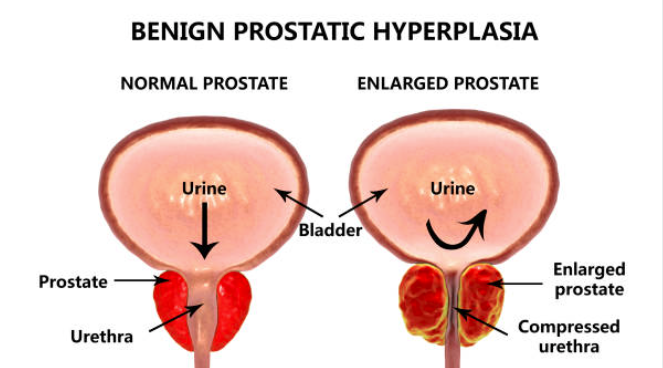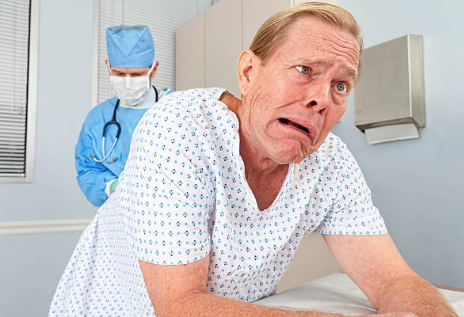BPH Urology Treatment: What you must know.

BPH Urology Treatment: What you must know about Prostate Health After 40
Gentlemen, as we cross the threshold of our forties, there’s a silent change that might start creeping up on us. Those once-effortless bathroom trips might become less predictable and a tad more frequent. Has your sleep schedule begun revolving around bathroom breaks? This might be your body sounding the alarm about BPH.
What is BPH Exactly?
BPH stands for Benign Prostatic Hyperplasia. To break that down, “benign” means it’s not cancerous, “prostatic” refers to your prostate gland (a walnut-sized gland that’s vital for your reproductive system), and “hyperplasia” simply means an increase in size.
So, in essence, BPH means your prostate is getting bigger. Imagine a slowly inflating balloon inside you that starts making life a little more difficult.
Hold On, Why Is This Happening to Me?
Although the exact reasons behind BPH are still being debated, it’s widely accepted that changing hormone levels as we age play a major role. Think of it as your body going through a slightly delayed growth spurt – only this time, it’s your prostate taking center stage.
The Dreaded Symptoms: Is it Time to See a Urologist?
BPH Sneak Attack: The Symptoms You Can’t Ignore
BPH might creep up on you, so it’s important to be extra vigilant about these warning signs:
-
The Hesitation Game: Trouble getting your urine stream started. Do you find yourself standing there, staring at the wall, waiting for things to get moving? This frustrating delay is a classic sign of an enlarged prostate constricting your urethra (the tube that carries urine out).
-
The Weak Stream Special: Your flow isn’t what it used to be. Remember those powerful streams of your youth? BPH can turn that into a mere trickle. You might even have the sensation of the stream stopping and starting, making the whole process even more drawn-out.
-
Dribbling Frustrations: The feeling that you haven’t completely emptied your bladder. Even after you think you’re finished, those pesky dribbles can be embarrassing and uncomfortable. This lingering sensation is because the enlarged prostate makes it harder for your bladder to completely push out all the urine.
-
Nighttime Adventures: Frequent urges to use the bathroom, interrupting your precious sleep. Are you a regular on the nighttime bathroom circuit? BPH can seriously disrupt your sleep. You might even have trouble falling back asleep, leaving you feeling tired and groggy the next day.
-
Urgency Warning: The sudden, overwhelming need to go, like, right this second! This feeling can strike out of nowhere! It’s your bladder desperately trying to manage around that enlarged prostate, and it’s not giving you much warning time. This urgency can lead to anxiety and even accidents if you can’t find a bathroom quickly enough.
-
Don’t Ignore the Signs: Getting Your BPH Urology Diagnosis Is Key
If you’re experiencing any of those pesky prostate symptoms, don’t try to brush them off. Seeking a BPH Urology diagnosis is the first step towards managing those symptoms and getting your life back on track. Here’s a breakdown of what to expect when you visit a urologist:
-
The Chat: Your doctor will talk to you about your symptoms and medical history. This is your chance to be open and honest about how BPH is affecting your life. Explain the specific symptoms you’re experiencing, how long you’ve had them, and how severe they are. Your doctor will also review your overall medical history to identify any potential contributing factors.
-
The Physical Exam: This might include the infamous digital rectal exam (DRE) to check your prostate. While the DRE might seem a little intimidating, it’s a quick and valuable tool. Your urologist can feel the size and shape of your prostate directly, helping them assess if it’s enlarged. Don’t worry; the procedure is generally well-tolerated and provides crucial information for your BPH Urology Diagnosis.
-
Tests Galore: You might be asked to do a urine test, blood tests, or even imaging scans. These additional tests help your urologist rule out other conditions that might have similar symptoms and determine the severity of your BPH. Here are some possible tests:
- Urine Analysis: Checks for any infections or blood in your urine.
- PSA Blood Test: Measures the level of prostate-specific antigen (PSA), which can be elevated in cases of BPH or other prostate issues.
- Urodynamic Tests: These specialized tests evaluate how well your bladder and urethra are functioning.
- Ultrasound or Cystoscopy: Imaging techniques may be used in some cases to visualize your prostate and surrounding structures.
.
-

Urology BPH Treatment: Winning the Fight Against Frustrating Symptoms
The great news is that BPH is highly treatable! Once you get that diagnosis, your urologist will work closely with you to find the Urology BPH treatment approach that’s right for you. Here’s a breakdown of the range of options:
-
Watchful Waiting: For mild symptoms, your doctor might recommend simply monitoring the situation. If your symptoms are minor and don’t bother you too much, your urologist may suggest watchful waiting. This involves regular checkups to monitor any changes in your prostate or symptom severity.
-
Medicine Magic: There are medications that can help shrink your prostate or relax the muscles around it, improving urine flow. Several types of medication prove effective in managing BPH:
- Alpha-blockers: These relax the bladder neck muscles and muscle fibers in the prostate, making it easier to urinate. (Examples: tamsulosin, alfuzosin).
- 5-alpha reductase inhibitors: These medications work by blocking the production of a hormone that contributes to prostate growth, gradually shrinking the prostate over time (Examples: finasteride, dutasteride).
-
Minimally Invasive Procedures: These techniques offer a middle ground between medication and surgery, using heat or other methods to target prostate tissue. Minimally invasive options are often suitable when symptoms are more bothersome but you want to avoid the longer recovery time associated with surgery:
- TUMT (Transurethral microwave thermotherapy): Microwave energy heats and destroys excess prostate tissue.
- TUVP (Transurethral electrovaporization of the prostate): An electrical current removes prostate tissue.
- UroLift: Tiny implants are used to lift and hold the enlarged prostate tissue away from the urethra.
- Water vapor therapy: Steam is used to destroy prostate tissue.
-
Surgical Solutions: If your symptoms are severe or medicine doesn’t help, surgery may be necessary to remove the enlarged part of your prostate. While surgery carries more risks and has a longer recovery, it’s often the most effective solution for long-term relief of severe BPH symptoms:
- TURP (Transurethral resection of the prostate): The standard surgical procedure, where excess prostate tissue is removed through the urethra using a special instrument.
- Open Prostatectomy: In rarer cases where the prostate is very large, a traditional open surgery may be required.
Lifestyle Changes That Pack a Punch: Take Back Control of Your Bladder
While medication and procedures are key treatments for BPH, don’t underestimate the positive impact some simple lifestyle adjustments can have on managing your symptoms:
-
Bladder Bootcamp: Try “double voiding” (urinating twice in quick succession) to empty your bladder more fully. This technique is surprisingly effective! After you think you’ve finished urinating, wait a few minutes and try again. You might be surprised at how much more urine you can pass, reducing that frustrating dribbling.
-
Fluid Management: Cut back on those late-night beverages and be mindful of caffeine and alcohol. Here are some tips:
- Stay hydrated throughout the day: Don’t restrict fluids too much, but focus on drinking most of your daily intake earlier in the day.
- Limit evening fluid intake: This reduces those disruptive nighttime bathroom visits.
- Beware of bladder irritants: Caffeine (coffee, tea, some sodas) and alcohol can worsen urinary symptoms and make your bladder overactive.
-
Muscle Might: Pelvic floor exercises can help strengthen the muscles involved in urination. Also known as Kegel exercises, these simple moves target the muscles that support your bladder. A strong pelvic floor can improve bladder control and reduce urgency and leaking. Search online for “Kegel exercises for men” to find easy instructions.
Additional Lifestyle Changes for BPH Management
- Maintain a healthy weight: Obesity can worsen BPH symptoms.
- Exercise regularly: Physical activity not only improves overall health but may also contribute to better bladder function.
- Manage stress: While not a direct cause, stress can worsen your symptoms. Find stress-reducing activities that work for you.
Final Words of Empowerment
Don’t let BPH dictate your life. Own your prostate health, get informed and talk to your doctor. With the right knowledge, treatment, and lifestyle adjustments, you can manage this condition and reclaim those peaceful nights and hassle-free bathroom breaks.
Remember, you’re not alone in this fight!
FAQs: Your BPH Questions Answered
FAQ-1: What are the telltale signs of BPH?
ANSWER: Don’t ignore these warning signs that might signal an enlarged prostate:
- Trouble starting your urine stream
- A weak or interrupted urine flow
- The feeling that you haven’t fully emptied your bladder
- Frequent nighttime bathroom trips
- A sudden and overwhelming urge to urinate
FAQ-2: Why is getting a BPH urology diagnosis important?
ANSWER: Seeing a urologist is crucial because:
- It confirms if your symptoms are caused by BPH or another underlying issue.
- It helps determine the severity of your BPH, guiding the best treatment approach.
- It enables your doctor to monitor your prostate health over time and adjust treatment if needed.
FAQ-3: What are my BPH urology treatment options?
ANSWER: Treatment depends on the severity of your symptoms and personal preferences. Options usually include:
- Watchful waiting for mild cases
- Medications to shrink the prostate or relax bladder muscles
- Minimally invasive procedures to reduce prostate tissue
- Surgery for severe cases or when medication isn’t effective
FAQ-4: Can lifestyle changes help with BPH?
ANSWER: Yes! Simple adjustments can have a big impact:
- Try “double-voiding” to empty your bladder more completely.
- Manage your fluid intake, especially in the evenings.
- Be mindful of caffeine and alcohol, which can irritate the bladder.
- Strengthen your pelvic floor muscles with Kegel exercises.
FAQ-5: Will a BPH urology diagnosis change my life?
ANSWER: A BPH diagnosis doesn’t have to mean a drastic lifestyle change. With the right treatment and management, you can regain control of your bladder function and significantly improve your quality of life.
SEE ALSO: Latest Prostate Supplements >>
NOTE :
The information provided in this article and the rest of this website is intended for general knowledge and informational purposes only, and does not constitute medical advice. It is essential to consult a qualified healthcare professional for the diagnosis and treatment of any health condition. Never disregard professional medical advice or delay in seeking it because of something you have read in this article.

